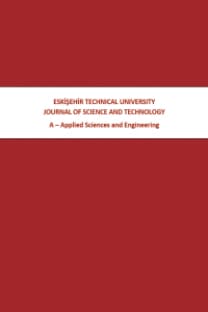AN EXPERIMENTAL STUDY ON THE EFFICIENCY OF CHROMIUM (VI) REMOVAL WITH STARCH-MAGNETITE NANOCOMPOSITE (Starch@MNPs)
Adsorption Chromium, Nanocomposite, Nanomagnetite,
___
- [1] El-Dib FI, Mohamed DE, El-Shamy OAA, Mishrif MR. Study the adsorption properties of magnetite nanoparticles in the presence of different synthesized surfactants for heavy metal ions removal. Egypt J Pet 2019; 1-7 .
- [2] Ghaseminezhad SM, Shojaosadati SA. Evaluation of the antibacterial activity of Ag/Fe3O4 nanocomposites synthesized using starch. Carbohydr Polym 2016; 144: 454–463.
- [3] Hamidian H, Tavakoli T. Preparation of a new Fe3O4/starch-g-polyester nanocomposite hydrogel and a study on swelling and drug delivery properties. Carbohydr Polymers 2016; 144: 140–148.
- [4] Lagergren S. About the theory of so-called adsorption of soluble substance. Kung Sven Veten Hand 1898; 24: 1-39.
- [5] Ho YS, Mckay G. Pseudo-second order model for sorption processes. Process Biochem 1999; 34: 451-465.
- [6] Weber Jr WJ, Morriss JC. Kinetics of adsorption on carbon from solution. J Sanit Eng Div 1963; 89: 31–60.
- [7] Cornwell RM, Schwertmann U. The Iron Oxides: Structure, Properties, Reactions, Occurrences and Uses. 2nd. Ed. Wiley-VCH, 2006.
- [8] Zheng L, Su W, Qi Z, Xu Y, Zhou M, Xie Y. First-order metal–insulator transition and infrared identification of shape-controlled magnetite nanocrystals. Nanotechnology 2011; 22: 485-706.
- [9] Gotić M, Musić S. FT-IR and FE-SEM investigation of iron oxides precipitated from FeSO4 solutions. J Mol Struct 2007; 834: 445-453.
- [10] Holland H, Yamaura M. Synthesis of magnetite nanoparticles by microwave irradiation and characterization. In: Internacional Latin American Conference On Powder Technology; 08-10 November 2009; Atibaia SP, Brazil. Pp. 1-6.
- [11] Uysal Y, Dergi ZÇ, Şimşek R. Atıksudan Mn+2 iyonlarının pektin kaplı nano manyetit kullanılarak giderilmesi. In: International Symposium on Urban Water and Wastewater Management; 25-27 October 2018; Denizli, Turkey. pp. 915-916.
- [12] Singh PN, Tiwary D, Sinha I. Starch-functionalized magnetite nanoparticles for hexavalent chromium removal from aqueous solutions. Desalin Water Treat 2016; 57: 12608-12619.
- [13] Somu P, Kannan U, Paul S. Biomolecule functionalized magnetite nanoparticles efficiently adsorb and remove heavy metals from contaminated water. J Chem Technol Biotechnol 2019; 94: 2009-2022.
- [14] Elfeky SA, Mahmoud SE, Youssef AF. Applications of CTAB modified magnetic nanoparticles for removal of chromium (VI) from contaminated water. J Adv Res 2017; 8:435-443.
- [15] Chowdhury SR, Yanful EK. Arsenic and chromium removal by mixed magnetite–maghemite nanoparticles and the effect of phosphate on removal. J Environ Manage 2010; 91:2238-2247.
- [16] Bagbi Y, Sarswat A, Mohan D, Pandey A, Solanki PR. Lead and chromium adsorption from water using L-Cysteine functionalized magnetite (Fe3O4) nanoparticles. Sci Rep 2017; 7:7672.
- [17] Zhang K, Li H, Xu X, Yu H. Synthesis of reduced graphene oxide/NiO nanocomposites for the removal of Cr(VI) from aqueous water by adsorption. Micropor Mesopor Mat 2018; 255: 7–14. [18] Khan SU, Zaidi R, Hassan SZ, Farooqi IH, Azam A. Application of Fe-Cu binary oxide nanoparticles for the removal of hexavalent chromium from aqueous solution. Water Sci and Technol 2016; 165-175.
- [19] Dey S, Bhattacharjee S, Chaudhuri MG, Bose RS, Halder S, Ghosh, CK. Synthesis of pure nickel (III) oxide nanoparticles at room temperature for Cr(VI) ion removal. RSC Advances 2015; 5:54717–54726.
- [20] Babaei AA, Ahmadi M, Goudarzi G, Jaafarzadeh N, Baboli Z. Adsorption of chromium (VI) from saline wastewater using spent tea-supported magnetite nanoparticle. Desalin Water Treat 2015; 57:12244–12256.
- ISSN: 2667-4211
- Yayın Aralığı: Yılda 4 Sayı
- Başlangıç: 2000
- Yayıncı: Eskişehir Teknik Üniversitesi
Massa ALSAFADI, Ümmühan BAŞARAN FİLİK
Gordana KAPLAN, Zehra YİĞİT AVDAN
Tuba Nur SERTTAŞ, Ömer Nezih GEREK, Fatih Onur HOCAOĞLU
Rojin ŞİMŞEK, Buşra Nur ÇİFTCİ, Yağmur UYSAL
Semih ERGİN, Selcan KAPLAN BERKAYA, Alper Kürşat UYSAL, Efnan ŞORA GÜNAL, Serkan GUNAL, Mehmet Bilginer GÜLMEZOĞLU
